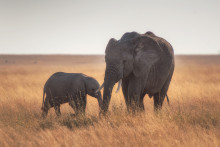Tiejun Wang is an Associate Professor in Ecological Remote Sensing with a focus on wildlife monitoring, an expertise which has landed him a spot on a team with researchers at the University of Oxford. Together they developed a technique to use satellite imagery and deep learning to detect and count African elephants.
Pandas
Why even try monitoring elephants from space? Surprisingly, Wang’s answer to this question involves another famous mammal: giant pandas. ‘Before I came to the Netherlands twenty years ago, I worked as a park ranger in China, protecting giant pandas,’ he says. ‘I love animals and I want to protect them, which is why I decided to be a scientist and study natural resources management at ITC. I saw firsthand how important it is to protect the animals’ habitat and Earth observation technology is one of the best ways to do that.’
Tiejun Wang during his career as park ranger in China.
The UT researcher began his scientific career by studying the natural habitat of giant pandas, mapping distribution of bamboo, which the animals live on. Thanks to this experience, he started supervising PhDs with similar focus, including Festus Ihwagi who worked on monitoring poaching of elephants. ‘I didn’t know anything about elephants until then,’ says Wang. ‘I didn’t even see a wild elephant until five years ago. But soon I found out that they are magnificent creatures that have been struggling due to human disturbance. It is estimated that 100.000 elephants were killed by poachers between 2010 and 2012. If that would continue, we lose these animals completely. But to protect them we need to know where they are and how many there are. And that got me thinking…’
Satellites
‘What is the best method for monitoring the elephant population in Africa?’ continues Wang. ‘In the last five decades, the best method we’ve had is aerial counts from manned aircrafts, meaning rangers flying above savannah and manually counting the animals. This is very logistically difficult, it disturbs the animals because the airplanes make noise, it is not completely accurate and it is quite expensive. All in all, it is very challenging. So I was thinking: can’t we use satellite technology to do this?’
'Can't we use satellite technology to do this?'
Yes, we can, is the answer. With many (commercial) satellites launched into space in recent years, scientists have a new tool at their disposal: high-resolution images from space. ‘When I looked at these images, I was able to see wildebeest in open savannah in Kenya. If I can see them with the naked eye, I can train a machine to automatically detect them. So I decided to use satellites to detect wild animals,’ explains Wang. ‘I was successful. In 2014, we were the first ever to map animals on land using satellite images. That gave me confidence. Even though the method was too complicated and difficult to upscale at the time, I knew I should pursue it.’
Oxford
The development got another boost two years ago, when Tiejun Wang was asked to be an external supervisor for PhD candidate Isla Duporge at Oxford. ‘We were allowed to download a lot of WorldView 3 satellite images, the highest resolution satellite imagery currently available. And using deep learning, we set out to develop a method to map elephants in heterogenous environments, so both savannahs and woodlands in South Africa. That is something completely new. I wasn’t sure if it could even work, but we had to try.’

Once again, it turns out that it does work. ‘The deep learning method is very accurate,’ says the ITC researcher. ‘It is comparable to human detection, but it is much faster – we let the algorithm do all the work. This is the first time something like this was accomplished. We can use the method for monitoring elephants, but it could also be applied to other species.’
Conservation
Ultimately, Wang hopes this technique can help protect wildlife, the very reason he became a scientist in the first place. ‘It could eventually be used for conservation efforts. Elephants are amazing creatures and perhaps the technology helps us understand their population trends better. You need to remember: we don’t protect them because they are cute. They are important to the environment and they are sort of flagship animals, like pandas. People love them, they are important to us, too.’








